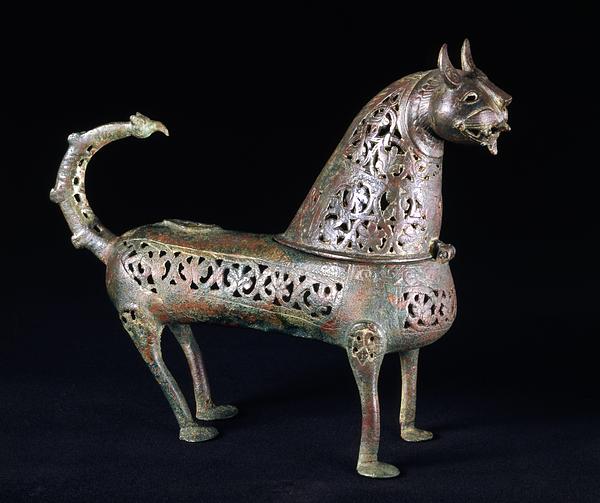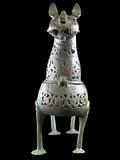Incense burner, cast bronze with openwork and engraved decoration
Eastern Iran or Afghanistan; 11th-12th century
H: 24.5; L: 29.5 cm
Trade with incense (luban) was an important source of income for the Arabs from ancient times, and this substance for “improving the air” was also used by the Muslims. A number of incense burners were designed as animals, with lions found most frequently. As in this case, the animal’s natural shape was often ignored and instead it was given stylized, non-naturalistic features, often vegetal ornamentation. The tail was given a life of its own and became an independent being.
The head was tipped open, coal embers were placed in the animal’s belly, and incense was sprinkled on top.
Incense burners in the form of a lion are found in many different sizes. The Metropolitan Museum of Art in New York City has the largest one, 82.6 cm long.
Inv. no. 48/1981
Published in:
Toby Falk og Douglas Barrett: Gods, gardens and elephants : an exhibition, 17th June to 17th July 1981, Colnaghi, London 1981, cat.no. 16;
Kjeld von Folsach: Davids Samling gennem 24 år, 1962-1985 = The David Collection: a 24-year period: 1962-1985, København 1985, pp. 50-51;
Art from the World of Islam. 8th-18th century, Louisiana, Humlebæk 1987, cat.no. 47;
Kjeld von Folsach: Islamic art. The David Collection, Copenhagen 1990, cat.no. 308;
Kjeld von Folsach: Fabelvæsner fra Islams Verden, Davids Samling, København 1991, p. 15 and cat.no. 30;
Kjeld von Folsach, Torben Lundbæk and Peder Mortensen (eds.): Sultan, Shah and Great Mughal: the history and culture of the Islamic world, The National Museum, Copenhagen 1996, cat.no. 136;
Kjeld von Folsach: Art from the World of Islam in The David Collection, Copenhagen 2001, cat.no. 471;
Sheila S. Blair and Jonathan M. Bloom (eds.): Cosmophilia. Islamic Art from the David Collection, Copenhagen, McMullen Museum of Art, Boston College, Boston 2006, cat.no. 117;
Sabiha Al Khemir: Beauty and belief: crossing bridges with the arts of Islamic culture, Brigham Young University Museum of Art, Provo 2012, pp. 118-119, 221;
Joachim Meyer: Sensual Delights: Incense Burners and Rosewater Sprinklers from the World of Islam, The David Collection, Copenhagen 2015, cat.no. 4;
Sheila R. Canby [et al.]: Court and cosmos: the great age of the Seljuqs, Metropolitan Museum of Art, New York, New Haven 2016, cat.no. 136a, p. 219;
Elizabeth C. Kelly: Zoomorphic incense burners of Medieval Khurasan: a study of Islamic metalwork, Oxford 2024, fig. C.14.1, fig. C.14.2A-C.14.2B, figs. C.14.3A- C.14.3D, figs. C.14.4A-C14.4B, figs. C.14.5A-C14.5C, fig. 7.12C, fig. 4.3C, fig. 4.7H, fig. 4.11E;


